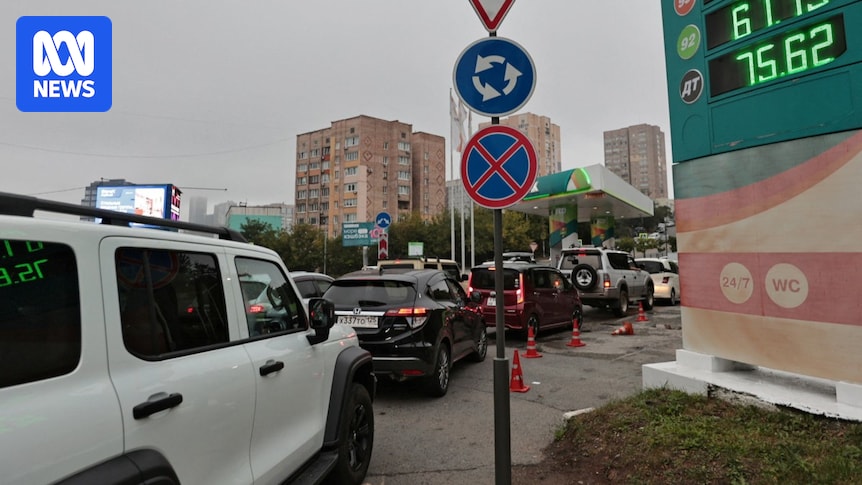Petrol shortages have been plaguing several regions in Russia, as Ukraine escalates its attacks on the country’s oil refineries.
Ukraine has pounded Russian energy facilities with several key refineries hit this month, including the Lukoil refinery in Volgograd, which is the largest in southern Russia.
In some parts of Russia’s east, long lines of cars and trucks have been stretching kilometres at petrol stations, only for drivers to find “out of order” signs and some blends of petrol unavailable.
The repeated drone and missile attacks have sent petrol prices in Russia to record highs.
Wholesale prices have risen by nearly 10 per cent this month and by nearly 50 per cent since the beginning of the year, according to data from the St Petersburg stock exchange.
Ukraine’s long-range drone strikes have reportedly knocked out about 13 per cent of Russia’s oil refining capacity since the beginning of the month.
According to Russian news outlet Interfax, the average petrol price in the country on August 18 was about 63 roubles ($1.20) per litre.
While that’s still cheaper than Australia, the median monthly wage in Australia is more than six times higher than in Russia, according to official data from both countries.
A blaze can be seen at an oil refinery near the Russian city of Novoshakhtinsk. (X: @igorsushko)
Jenny Mathers, a senior lecturer in international politics at Aberystwyth University, said the strikes were designed to try to hurt President Vladamir Putin’s ability to keep funding the war in Ukraine.
“Energy is Russia’s number one export by a long way, so keeping those exports flowing is an important way for Russia to continue to pursue the war the way it’s been pursuing it,” she said.
“Ukraine, obviously knowing that, has made targeting the facilities one of its high priorities, so it has developed over the past months the ability to strike targets quite deep inside Russia.”
While the European Union, United States and many of their allies have imposed sanctions on Russia’s energy sector, the Kremlin circumvents many measures using its so-called “shadow fleet” of tankers to export oil.
Inside the mission to stop Putin’s ‘ghost ships’ wreaking havoc on the seas
Some Ukrainians see the current wave of drone attacks as a form of “direct sanctions” and taking matters into their own hands.
The Russian government has blamed the shortages on refinery maintenance and peak demand for fuel in summer.
Sergei Aksyonov, the Russian-appointed head of Crimea — which Russia annexed from Ukraine in 2014 — acknowledged the petrol issues in an interview with a Russian TV station and warned the shortages would continue.
“Unfortunately, some petrol stations in Crimea are currently experiencing shortages of certain types of fuel,” he said.
“This is due to both a decrease in production volumes and logistics, a significant portion is delivered to the region by road.
“This is an objective situation, which could last for up to a month or more.”
This oil refinery near the Russian city of Syzran was also targeted. (X: @igorsushko)
Svetlana Bazhanova lives in the biggest city on the peninsula, Sevastopol, and said the shortages were causing “big problems”.
“We will endure, but this is a big hit to our family budget, it’s a big hit. It’s really noticeable,” she told the Reuters news agency.
Ukraine’s foreign intelligence service reported last week that Russia imposed strict fuel rationing on civilians in the remote Kuril islands.
“It would seem the state is sacrificing supplies to domestic consumers in order to keep foreign buyers happy, so this is a way that you see the domestic economy being squeezed in order to fulfil the needs of the war,” Dr Mathers said.
“The big question is. can Ukrainians maintain this level or even increase this level of attack and really put a lot of pressure on Russia? Will it be a short-term inconvenience for Russians, or will it turn into something that has more of a long-term impact?
“It certainly isn’t good news for the Russian economy, but of course it doesn’t mean they are going to surrender, it’s more incremental pressure being put on them, which is part of Ukraine’s strategy.”
Smoke rises from Russia’s Unecha oil pumping station last week, which disrupted supply to Slovakia and Hungary. (YouTube: @magyarbirds via Reuters)
Ukraine has also been trying to prevent Russian exports of oil.
Last week, its drones struck a key pumping station on the Druzhba oil pipeline that supplies Russian oil to Hungary and Slovakia, which are the only EU member states still receiving oil from Russia.
The Hungarian and Slovakian governments wrote to the EU, warning the attack meant oil supplies could be suspended for at least five days, and urged Brussels to step up to secure the flow of oil.
“The physical and geographical reality is that without this pipeline, the safe supply of our countries is simply not possible,” their letter said.
Hungarian Prime Minister Viktor Orban released a letter he had sent to US President Donald Trump about the strike.
In it, he said Ukraine had attacked the Druzhba pipeline just days before Mr Trump’s August 15 summit with Russian President Vladimir Putin in Alaska, calling the move a “very unfortunate” escalation.
A copy of the letter posted on Facebook appeared to include Mr Trump’s handwritten response: “Viktor, I do not like hearing this, I am very angry about it.”
The White House has not commented.
Moscow routinely targets Ukraine’s gas infrastructure, which is crucial for winter heating and fuel.
